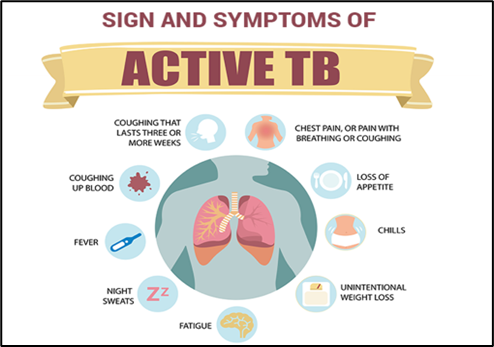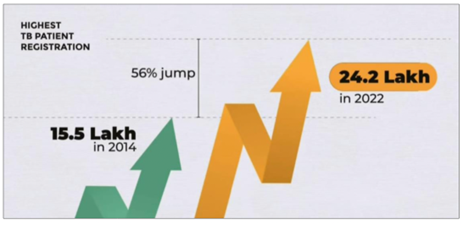Why in the News?
- India is set to roll out the novel BPaLM regimen for drug-resistant tuberculosis therapy by training healthcare professionals in administering it.
What’s in Today’s Article?
- About TB (Description, Symptoms, Types, Treatment, TB in India, etc.)
- Challenges
- News Summary
About Tuberculosis (TB):
- Tuberculosis (TB) is a bacterial infection spread through inhaling tiny droplets from the coughs or sneezes of an infected person.
- It mainly affects the lungs, but it can affect any part of the body, including the tummy (abdomen), glands, bones and nervous system.
- TB is a potentially serious condition, but it can be cured if it's treated with the right antibiotics.
Symptoms of TB:

Types of TB:
- Pulmonary TB:
- TB that affects the lungs (pulmonary TB) is the most contagious type, but it usually only spreads after prolonged exposure to someone with the illness.
- In most healthy people, the body's natural defence against infection and illness (the immune system) kills the bacteria and there are no symptoms.
- Latent TB:
- Sometimes the immune system cannot kill the bacteria, but manages to prevent it spreading in the body.
- You will not have any symptoms, but the bacteria will remain in your body. This is known as latent TB.
- People with latent TB are not infectious to others.
- Active TB:
- If the immune system fails to kill or contain the infection, it can spread within the lungs or other parts of the body and symptoms will develop within a few weeks or months. This is known as active TB.
- About one-quarter of the world’s population is estimated to be infected by TB bacteria but out of these only 5-15% of people will fall ill with active TB disease.
- Latent TB could develop into an active TB disease at a later date, particularly if your immune system becomes weakened.
Treatment:
- With treatment, TB can almost always be cured.
- A course of antibiotics will usually need to be taken for 6 -18 months.
- Several different antibiotics are used because some forms of TB are resistant to certain antibiotics.
Tuberculosis in India:

- The total number of incident TB patients (new and relapse) notified during 2021 in India were 19.33 lakh as opposed to that of 16.28 lakh in 2020.
- In 2022, 24.22 lakh cases of TB were registered in the country.
- India continues to have the largest share of the global TB burden.
- India’s National TB Elimination Programme is strengthened to meet the goal of ending the TB epidemic by 2025 from the country, five years ahead of the Sustainable Development Goals (SDG) for 2030.
- The National Strategic Plan for Tuberculosis Elimination (2017-2025) was developed to achieve the goal.
- Though the National Strategic Plan for Tuberculosis Elimination (2017-2025) outlined a paradigm shift in approach and strategy to achieve the ambitious goal, by 2020, it became clear that the NSP will not be able to meet these objectives.
- A new National Strategic Plan for Tuberculosis Elimination (2020-2025) to end TB was launched.
Challenges Associated with TB Eradication in India:
- Poor primary health-care and infrastructure in rural areas;
- Unregulated private health care;
- HIV induced TB cases;
- Lack of hygiene facilities and widespread malnourishment and poverty.
- The main variables that help understand tuberculosis transmission are rapid unplanned urbanization, overcrowding, poor airborne infection control, poor nutrition, HIV, diabetes and tobacco use.
Rollout of New Regimen for Drug-resistant TB:
- About the news
- India is set to roll out the novel BPaLM regimen for drug-resistant tuberculosis (TB), following the World Health Organization's recommendation nearly two years ago.
- This regimen, expected to significantly improve treatment outcomes and quality of life for TB patients, will be implemented through a training program for healthcare professionals.
- Currently, TB patients in nearly 40 countries have access to this new regimen, which has proven to be more effective.
- The training will begin in late August or early September in Mumbai and expand to five other locations across the country.
- About BPaLM regimen
- The BPaLM regimen is a new, oral treatment for drug-resistant tuberculosis (TB). It's a six-month regimen that combines bedaquiline (B), pretomanid (Pa), linezolid (L), and sometimes moxifloxacin (M).
- The regimen is recommended for people with MDR/RR-TB and pre-XDR-TB, but not for extrapulmonary TB involving the central nervous system or osteoarticular and disseminated TB.
- Benefits
- This rollout is anticipated to boost India's National Tuberculosis Elimination Programme, aiming to eradicate TB by 2025.
- Shorter duration: The BPaLM regimen is a six-month treatment, compared to 18 months for standard care.
- Lower cost: The BPaLM regimen is less expensive than standard care.
- Lower pill burden: The BPaLM regimen involves fewer pills than standard care.
- High efficacy: The BPaLM regimen has a success rate of 89% within six months, compared to 52% for standard care.









